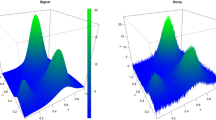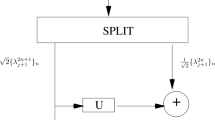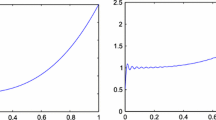Abstract
A new approach is presented to ensure exact conditioning of Gaussian fields on wavelet decomposition coefficients and hard data. The approach uses a matrix formulation of discrete wavelet decomposition enabling to compute all the required covariances and cross-covariances between hard data, points to simulate and the imposed wavelet coefficients at all scales. Two small examples show that the approach reproduces exactly the information provided, even when the wavelet information is unrelated to the true underlying image. For larger images, the approach of post-conditioning by cokriging is used to palliate the strong memory requirements of the matrix approach. The modified method remains exact and is shown to be computationally realistic for large problems. This marks a significant improvement over previously published methods where conditioning to wavelet coefficients was only approximate. After soft data calibration to wavelet coefficients at a given scale, the approach enables to simulate realizations fully consistent with the known wavelet coefficients and available hard data.









Similar content being viewed by others
References
Anderson T (2003) An introduction to multivariate statistical analysis, 3rd edn. Wiley, New York
Asli M, Marcotte D, Chouteau M (2000) Direct inversion of gravity data by cokriging. In: Kleingeld WJ, Krige DG (eds) Geostatistics 2000, Cape Town, South Africa, pp 64–73
Awotunde A, Horne R (2013) Reservoir description with integrated multiwell data using two-dimensional wavelets. Math Geosci 45:225–252
Azimifar Z, Fieguth P, Jernigan E (2002) Hierarchical multiscale modeling of wavelet-based correlations. In: Structural, syntactic, and statistical pattern recognition; Lecture Notes in Computer Science, vol 63, pp 850–859
Bosch E, Gonzlez A, Vivas J, Easley G (2009) Directional wavelets and a wavelet variogram for two-dimensional data. Math Geosci 41:611–641
Chatterjee S, Dimitrakopoulos R (2012) Multi-scale stochastic simulation with a wavelet-based approach. Comput Geosci 45:177–189
Chatterjee S, Dimitrakopoulos R, Mustapha H (2012) Dimensional reduction of pattern-based simulation using wavelet analysis. Math Geosci 44:343–374
Chilès JP, Delfiner P (1999) Geostatistics: modeling spatial uncertainty, 1st edn. Wiley-Interscience, New York
Chilès JP, Delfiner P (2012) Geostatistics: modeling spatial uncertainty, 2nd edn. Wiley-Interscience, New York
Daubechies I (1988) Orthonormal bases of compactly supported wavelets. Communications on pure and applied mathematics 41:909–996
Daubechies I (1992) Ten lectures on wavelets. SIAM, CBMS-NSF Lecture Notes No. 61
Dubreuil-Boisclair C, Gloaguen E, Marcotte D, Giroux B (2011) Heterogeneous aquifer characterization from gpr tomography and borehole hydrogeophysical data using nonlinear Bayesian simulations. Geophysics 76(4):J13–J25
Gastaldi C, Roy D, Doyen P, Den Boer L (1998) Using Bayesian simulations to predict reservoir thickness under tuning conditions. Lead Edge 17:589–593
Gloaguen E, Dimitrakopoulos R (2009) Two-dimensional conditional simulations based on the wavelet decomposition of training images. Math Geosci 41(6):679–701
Gloaguen E, Marcotte D, Chouteau M, Perroud H (2005) Borehole radar velocity inversion using cokriging and cosimulation. J Appl Geophys 57:242–259
Gloaguen E, Giroux B, Marcotte D, Dubreuil-Boisclair C, Tremblay-Simard P (2011) Multiple scale porosity wavelet simulation using gpr tomography and hydrogeophysical analogues, chap 7 in advances in near-surface seismology and ground-penetrating radar. SEG. doi:10.1190/1.9781560802259
Hielscher R, Schaeben H (2008) Multi-scale texture modeling. Math Geosci 40(1):63–82
Hruka M, Corea W, Seeburger D, Schweller W, Crane W (2009) Automated segmentation of resistivity image logs using wavelet transform. Math Geosci 41:703–716
Le Ravalec M, Noetinger B, Hu L (2000) The fft moving average generator: an efficient numerical method for generating and conditioning gaussian simulations. Math Geol 32:701–722
Mallat S (1999) A wavelet tour of signal processing, 2nd edn. Academic Press, New York
Marcotte D (1991) Cokriging with matlab. Comput Geosci 17:1265–1280
Marcotte D (1995) Generalized cross-validation for covariance model selection and parameter estimation. Math Geol 27:749–762
Meyer Y (1990) Ondelettes et opérateurs, tomes I, II et III., vol 63. Hermann, Paris
Milne A, Lark R (2009) Wavelet transforms applied to irregularly sampled soil data. Math Geosci 41:661–678
Nason G (2008) Wavelet methods in statistics with R (Use R). Springer, New York
Shamsipour P, Marcotte D, Chouteau M, Keeting P (2010) 3D stochastic inversion of gravity data using cokriging and cosimulation. Geophysics 71:1–10
Strang G, Nguyen T (2002) Wavelets and filter banks, vol 63. SIAM, New Delhi
Tran T, Mueller U, Bloom L (2001) Conditional simulation of two-dimensional random processes using Daubechies wavelets. In: Proceeding of the MODSIM 2001 international congress on modelling and simulation. Modelling and simulation society of Australia and New Zealand, pp 1991–1996
Vidakovic B (1999) Statistical modeling by wavelets. Wiley, New York
Wackernagel H (2003) Multivariate geostatistics: an introduction with applications, 3rd edn. Springer, Berlin
Wang H, Vieira J (2010) 2-D wavelet transforms in the form of matrices and application in compressed sensing. In: Proceedings of the 8th World Congress on Intelligent Control and Automation July 6–9 2010. Jinan, China, pp 35–39
Watkins L, Neupauer GM, Compo RM (2009) Wavelet analysis and filtering to identify dominant orientations of permeability anisotropy. Math Geosci 41:643–659
Zeldin B, Spanos P (1995) Random field simulation using wavelet bases. In: Lemmaire M, Favre JL, Mébarki A (eds) Applications of statistics and probability-civil engineering reliability and risk analysis. Balkema, Rotterdam, pp 1275–1983
Zeldin B, Spanos P (1996) Random field representation and synthesis using wavelet bases. J Appl Mech 63:946–952
Zhang L, Bai G, Zhao Y (2012) A method for eliminating caprock thickness influence on anomaly intensities in geochemical surface survey for hydrocarbons. Math Geosci 44:929–944
Acknowledgments
Part of this research was financed by the National Science and Engineering Research Council of Canada. Helpful comments from two anonymous reviewers are acknowledged.
Author information
Authors and Affiliations
Corresponding author
Appendix: Proof of Exact Conditioning on HD and Wavelet Coefficients
Appendix: Proof of Exact Conditioning on HD and Wavelet Coefficients
The sampling matrix \(\mathbf {H}\), of size \( m \times n_t\) (with \(n_t=n_1+n_2\)) recovers all the image pixels (HD or to simulate) in vector \(\mathbf {y}\). Each row of this matrix has a single 1 in the column corresponding to a pixel, and 0 elsewhere. One has
where \(\mathbf {z}_{\mathbf {sim}}\) is the vector of length \(m\) extracted from the simulated vector \(\mathbf {y}_{\mathbf {sim}}=\left[ \begin{array}{c} \mathbf {y}_{\mathbf {1 \cdot 2}} \\ \mathbf {y}_{\mathbf {2}} \end{array} \right] \), and where \(\mathbf {y}_{\mathbf {1 \cdot 2}}\) is obtained from Eq. 11.
Defining the \(m \times n_t\) matrix \({\tilde{\mathbf {F}}}\) as simply \(\mathbf {F}\) with lines reordered following the partition in \(\mathbf {y}\), matrix \({\tilde{\mathbf {F}}}\) can also be partitioned as
With these definitions, one has
Using Eqs. 10, 11, and 15 and posing \(\mathbf {r=Lx}\), and noting that \({\mathbf {y}}_{\mathbf {2}}=\tilde{\mathbf {F}}_{\mathbf {2}}\mathbf {z}\)
The latter can be rewritten as
Because \(\mathbf {H}\tilde{\mathbf {F}}=\mathbf {I}_{\mathbf {m}}\), one gets
Using Eqs. 10 and 15, the vector \(\tilde{\mathbf {F}}_{\mathbf {2}}\mathbf {H}\left[ \begin{array}{c} \mathbf {r}\\ \mathbf {0} \end{array} \right] \) has variance-covariance matrix
The right member can be rewritten, as
using again the equality \(\mathbf {H}\tilde{\mathbf {F}}=\mathbf {I}_{\mathbf {m}}\), and simplifying, one gets \(\mathbf {K}=\mathbf {0}\), which implies that \(\tilde{\mathbf {F}}_{2}\mathbf {H}\left[ \begin{array}{c} \mathbf {r}\\ \mathbf {0} \end{array} \right] = \mathbf {0}\) as \(E[\mathbf {r}]=\mathbf {0}\). Hence, substituting in Eq. 18,
which proves that all the HD data and wavelet coefficients are exactly reproduced.
Rights and permissions
About this article
Cite this article
Marcotte, D., Gloaguen, E. Exact Conditioning of Gaussian Fields on Wavelet Coefficients. Math Geosci 47, 277–300 (2015). https://doi.org/10.1007/s11004-014-9552-z
Received:
Accepted:
Published:
Issue Date:
DOI: https://doi.org/10.1007/s11004-014-9552-z




